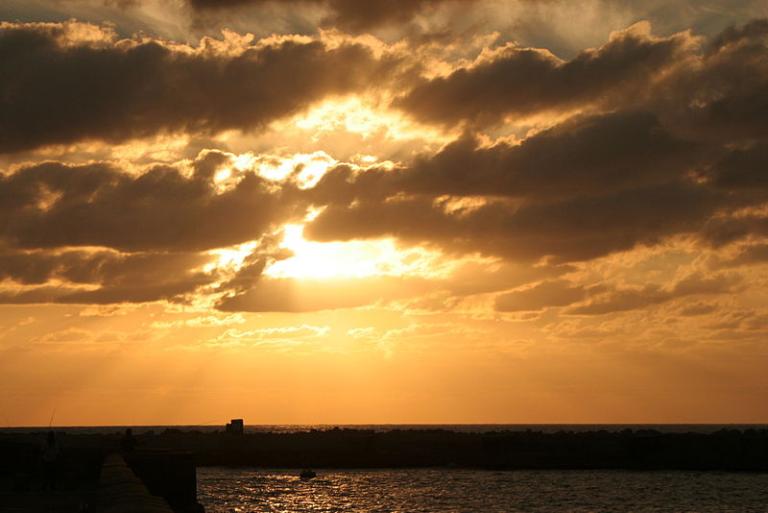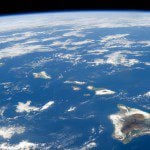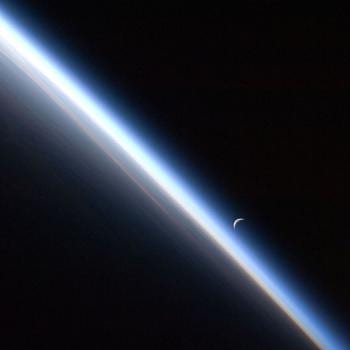
(Wikimedia Commons)
I posted something yesterday (“Water Worlds”) on oceans and water. And, having just flown over thousands of miles of ocean during the past few hours, and sitting now looking at the Mediterranean Sea, the topic is still on my mind. So here’s a column that I published in the Deseret News back on 20 July 2017:
“Ocean, n. A body of water occupying about two-thirds of a world made for man — who has no gills.”
So reads an entry in Ambrose Bierce’s deeply cynical and justly famous classic 1911 “Devil’s Dictionary” (which is online at ambrosebierce.org).
Bierce, an avowed religious agnostic, was suggesting that a world truly designed for humans wouldn’t have included large areas so inhospitable to human life.
It’s an amusing witticism, but it doesn’t hold up very well to scientific analysis. Obviously, a world entirely devoid of water wouldn’t sustain human life. But we’re beginning to realize how vital oceans and related terrestrial features are to our survival, and the more we learn about sensitive ecosystems everywhere — including the overall ecosystem of Earth itself — the less confident we are that they can simply be altered at human will without entailing unforeseen and sometimes grave consequences.
Earth’s oceans figure, of course, among humanity’s most important natural resources, furnishing enormous quantities of food, to say nothing of transportation, recreation and (perhaps a valuable resource in itself) sheer awe at their vastness. Their significance for biodiversity and for global material and energy cycles has only begun to be appreciated in recent generations. On a grand scale, oceans, atmosphere and land masses together constitute a global biosphere, a system for which Earth’s seas play a critical role not only in the well-known water cycle (of evaporation, rain, rivers and return to the sea) but in the recycling of nutrients and wastes and the regulation of climate and atmospheric gases.
Most of Earth’s “biomass,” for instance, the sheer weight of animated material on the planet, includes a wide and diverse range of oceanic organisms collectively known as “plankton.” “Zooplankton” or animal plankton feed on plant or “phytoplankton,” and in turn, feed birds (such as the Arctic terns who migrate to Antarctica’s Weddell Sea just in time for the annual blooming of plankton there) and fish and the krill that nourishes blue whales. Among them, too, the so-called Rhizarians play a vital role in reducing atmospheric carbon dioxide and exporting it from the upper layers of the sea to the depths of the oceans, thus helping to foster the relative oxygen richness on which we humans depend.
The world is a much more complex ecosystem than Bierce could possibly have realized when he wrote his “Devil’s Dictionary” more than a century ago. Earth would definitely not be more human-friendly without oceans. (In the current search for possible life-sustaining exoplanets, the presence or absence of bodies of water is a principal consideration.) Without bodies of water occupying about two-thirds of our planet’s surface, we might well have found this world completely uninhabitable — despite our lack of gills.
The interplay of land and ocean is apparent everywhere, but perhaps nowhere more obviously or inescapably than in the Hawaiian Islands, the most distant archipelago in the world from any continent. (Honolulu is located 2,558 miles from Los Angeles and 3,854 miles from Tokyo.)
Formed by a powerful undersea source of magma called the “Hawaiian hotspot” as the tectonic plate beneath much of the Pacific Ocean moves slowly but relentlessly toward the northwest, the Hawaiian Islands illustrate nature at its most creative but also at its most destructive. Over millions of years, volcanic eruptions and erosion have formed spectacular features, but they’ve been accompanied by earthquakes, massive landslides and tsunamis.
Such processes may seem clear evidence against any special divine concern for humans. On the other hand, plate tectonics, like water, may be a requirement for the emergence of life. By trapping atmospheric carbon dioxide into rocks, tectonic changes stabilized our climate and made Earth habitable.
Back, though, to water and oceans: Rain, it has been suggested (see “Earth’s Breathable Atmosphere Tied to Plate Tectonics?” by Johnny Bontemps on astrobio.net), takes carbon dioxide out of the atmosphere and puts it into streams of water that, by weathering land forms as they flow toward the sea, release phosphorus — an element essential for photosynthesis and, therefore, for the production and maintenance of the oxygen that’s indispensable for our survival.
Does this all seem complex and difficult? It should, because it is. Far beyond the worldview of the cynical Bierce. Our lives on this “pale blue dot” in the vastness of space depend on the often astoundingly precise interplay of a host of remarkable features. Bierce’s religious agnosticism rested, to at least some degree, on a view of science and the world that is no longer tenable.
Posted from Tel Aviv, Israel












